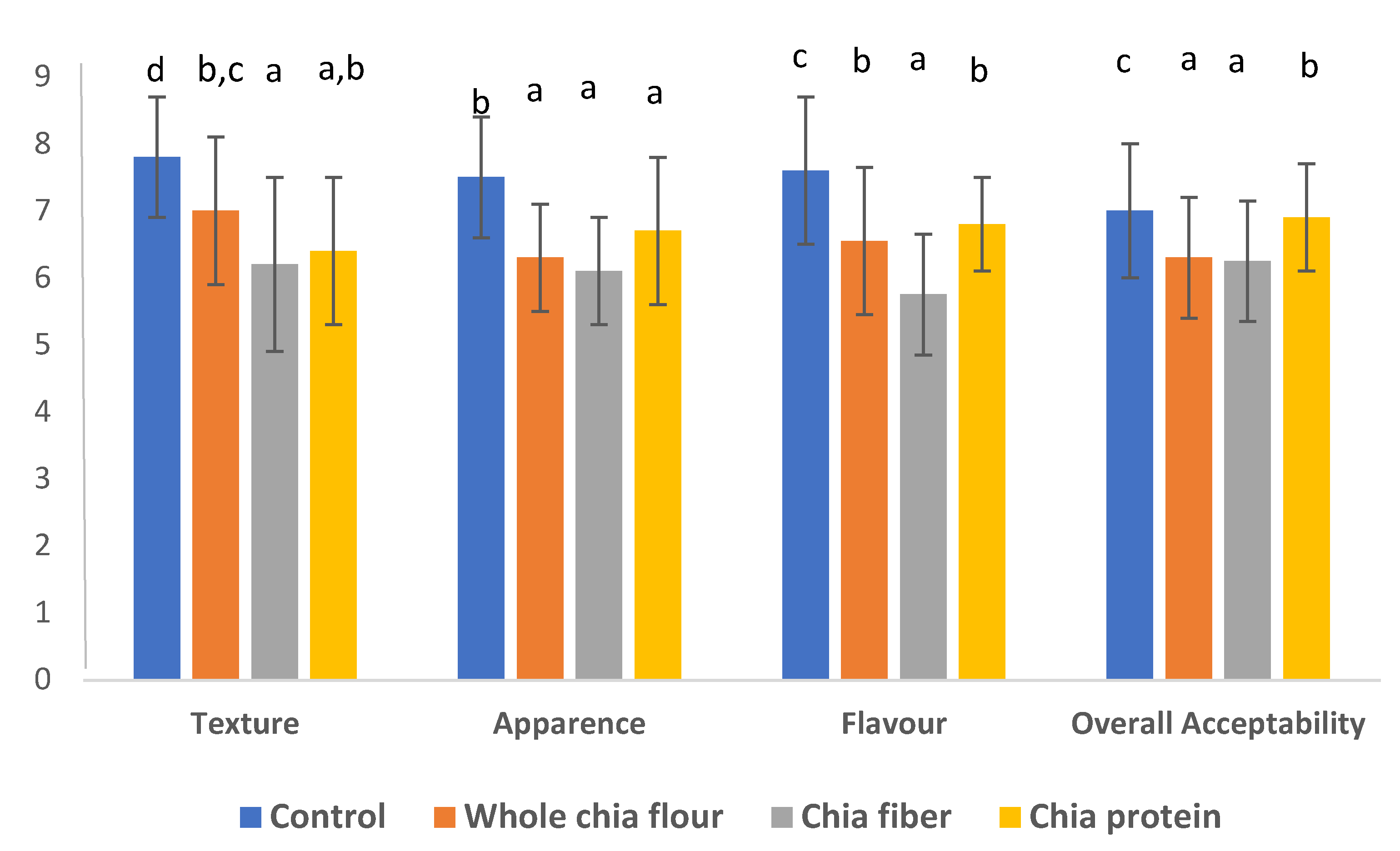Nutrient Composition of Fresh Pasta Enriched with Chia (Salvia hispanica L.) †
Abstract
1. Introduction
2. Materials and Methods
2.1. Raw Materials
2.2. Pasta Production
2.3. Chemical Composition
2.4. Preliminary Sensory Evaluation
2.5. Statistical Analysis
3. Results
4. Conclusions
Author Contributions
Funding
Institutional Review Board Statement
Informed Consent Statement
Data Availability Statement
Conflicts of Interest
References
- Tapsell, L.C.; Neale, E.P.; Satija, A.; Hu, F.B. Foods, Nutrients, and Dietary Patterns: Interconnections and Implications for Dietary Guidelines. Adv. Nutr. 2016, 7, 445–454. [Google Scholar] [CrossRef]
- Webb, D. Pasta’s History and Role in Healthful Diets. Food Nutr. 2019, 54, 213–220. [Google Scholar] [CrossRef]
- Li, M.; Zhu, K.X.; Guo, X.N.; Brijs, K.; Zhou, H.M. Natural additives in wheat-based pasta and noodle products: Opportunities for enhanced nutritional and functional properties. Compr. Rev. Food Sci. Food Saf. 2014, 13, 347–357. [Google Scholar] [CrossRef] [PubMed]
- Ullah, R.; Nadeem, M.; Khalique, A.; Imran, M.; Mehmood, S.; Javid, A.; Hussain, J. Nutritional and therapeutic perspectives of Chia (Salvia hispanica L.): A review. J. Food Sci. Technol. 2016, 53, 1750–1758. [Google Scholar] [CrossRef] [PubMed]
- Biró, B.; Fodor, R.; Szedljak, I.; Pásztor-Huszár, K.; Gere, A. Buckwheat-pasta enriched with silkworm powder: Technological analysis and sensory evaluation. LWT 2019, 116, 108542. [Google Scholar] [CrossRef]
- AOAC. Method 925.09, 991.43, 996.11, 986.11. In Official Methods of Analysis, 15th ed.; Association of Official Analytical Chemists: Arlington, VA, USA, 1996. [Google Scholar]
- ISO/TS. Food Products—Determination of the Total Nitrogen Content by Combustion According to the Dumas Principle and Calculation of the Crude Protein Content—Part 1 and 2: Cereals, Pulses and Milled Cereal Products (ISO/TS 16634-1 and ISO/TS 16634-2); International Organization for Standardization (ISO): Geneva, Switzerland, 2016. [Google Scholar]
- McKie, V.; McCleary, B. A Novel and Rapid Colorimetric Method for Measuring Total Phosphorus and Phytic Acid in Foods and Animal Feeds. J AOAC Int. 2016, 99, 738–743. [Google Scholar] [CrossRef] [PubMed]
- Iglesias-Puig, E.; Monedero, V.; Haros, M. Bread with Whole Quinoa Flour and Bifidobacterial Phytases Increases Dietary Mineral Intake and Bioavailability. Food Sci. Technol. 2015, 60, 71–77. [Google Scholar] [CrossRef]




Publisher’s Note: MDPI stays neutral with regard to jurisdictional claims in published maps and institutional affiliations. |
© 2022 by the authors. Licensee MDPI, Basel, Switzerland. This article is an open access article distributed under the terms and conditions of the Creative Commons Attribution (CC BY) license (https://creativecommons.org/licenses/by/4.0/).
Share and Cite
Aja, S.; Haros, C.M. Nutrient Composition of Fresh Pasta Enriched with Chia (Salvia hispanica L.). Biol. Life Sci. Forum 2022, 17, 3. https://doi.org/10.3390/blsf2022017003
Aja S, Haros CM. Nutrient Composition of Fresh Pasta Enriched with Chia (Salvia hispanica L.). Biology and Life Sciences Forum. 2022; 17(1):3. https://doi.org/10.3390/blsf2022017003
Chicago/Turabian StyleAja, Silvia, and Claudia Monika Haros. 2022. "Nutrient Composition of Fresh Pasta Enriched with Chia (Salvia hispanica L.)" Biology and Life Sciences Forum 17, no. 1: 3. https://doi.org/10.3390/blsf2022017003
APA StyleAja, S., & Haros, C. M. (2022). Nutrient Composition of Fresh Pasta Enriched with Chia (Salvia hispanica L.). Biology and Life Sciences Forum, 17(1), 3. https://doi.org/10.3390/blsf2022017003





